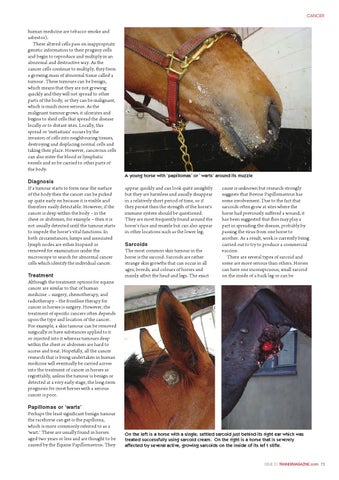cancer issue 31.qxd:Jerkins feature.qxd
19/8/10
20:44
Page 2
CANCER
human medicine are tobacco smoke and asbestos). These altered cells pass on inappropriate genetic information to their progeny cells and begin to reproduce and multiply in an abnormal and destructive way. As the cancer cells continue to multiply, they form a growing mass of abnormal tissue called a tumour. These tumours can be benign, which means that they are not growing quickly and they will not spread to other parts of the body, or they can be malignant, which is much more serious. As the malignant tumour grows, it ulcerates and begins to shed cells that spread the disease locally or to distant sites. Locally, this spread or ‘metastasis’ occurs by the invasion of cells into neighbouring tissues, destroying and displacing normal cells and taking their place. However, cancerous cells can also enter the blood or lymphatic vessels and so be carried to other parts of the body. Diagnosis If a tumour starts to form near the surface of the body then the cancer can be picked up quite early on because it is visible and therefore easily detectable. However, if the cancer is deep within the body – in the chest or abdomen, for example – then it is not usually detected until the tumour starts to impede the horse’s vital functions. In both circumstances, lumps and associated lymph nodes are either biopsied or removed for examination under the microscope to search for abnormal cancer cells which identify the individual cancer. Treatment Although the treatment options for equine cancer are similar to that of human medicine – surgery, chemotherapy, and radiotherapy – the frontline therapy for cancer in horses is surgery. However, the treatment of specific cancers often depends upon the type and location of the cancer. For example, a skin tumour can be removed surgically or have substances applied to it or injected into it whereas tumours deep within the chest or abdomen are hard to access and treat. Hopefully, all the cancer research that is being undertaken in human medicine will eventually be carried across into the treatment of cancer in horses as regrettably, unless the tumour is benign or detected at a very early stage, the long-term prognosis for most horses with a serious cancer is poor. Papillomas or ‘warts’ Perhaps the least significant benign tumour the racehorse can get is the papilloma, which is more commonly referred to as a ‘wart.’ These are usually found in horses aged two years or less and are thought to be caused by the Equine Papillomavirus. They
A young horse with ‘papillomas’ or ‘ warts’ around its muzzle
appear quickly and can look quite unsightly but they are harmless and usually disappear in a relatively short period of time, so if they persist then the strength of the horse’s immune system should be questioned. They are most frequently found around the horse’s face and muzzle but can also appear in other locations such as the lower leg. Sarcoids The most common skin tumour in the horse is the sarcoid. Sarcoids are rather strange skin growths that can occur in all ages, breeds, and colours of horses and mainly affect the head and legs. The exact
cause is unknown but research strongly suggests that Bovine Papillomavirus has some involvement. Due to the fact that sarcoids often grow at sites where the horse had previously suffered a wound, it has been suggested that flies may play a part in spreading the disease, probably by passing the virus from one horse to another. As a result, work is currently being carried out to try to produce a commercial vaccine. There are several types of sarcoid and some are more serious than others. Horses can have one inconspicuous, small sarcoid on the inside of a back leg or can be
On the left is a horse with a single, settled sarcoid just behind its right ear which was treated successfully using sarcoid cream. On the right is a horse that is severely affected by several active, growing sarcoids on the inside of its lef t stifle.
ISSUE 31 TRAINERMAGAZINE.com 73
